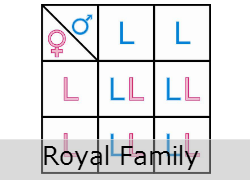Summary
For this mini project, the students were tasked with creating their very own “Royal Family” and asked to answer the essential question, “How is genetic information transmitted? ” Prior to introducing the project, the students in class discussed, and generated questions about genetic disorders. This cross-curricular activity analyzed a pedigree activity that follows a genetic disorder prevalent in Queen Victoria’s family.
At the onset of the Royal Family project, the students were encouraged to work in self-selected, collaborative groups of two. They were tasked with the objective of creating their own, original, royal family. Not only were they required to give their royal family a genetic disorder that could be traced throughout at least three generations, they also had to include five observable traits, a birth date, and a name for each family member. Students created Punnett squares for one family member at each generation, which had to be related to the parents the generation before. Lastly, the students had to include and predict a “future baby” in the project depending on the data obtained from the last generation. The baby’s genetic traits needed to be predicted using the parents traits, with a detailed illustrations of what the child would look like.
The groups were allowed to use any digital media (two pieces) they thought would appropriately display their project. Each partner was responsible for completing a peer collaboration form to assign group roles and groups had to evaluate the work of their partner. When the project was completed, students were evaluated using a rubric, which was given to the students before beginning the project. The wrap up consisted of the student reflecting on their overall thoughts via. a Google form.
TIPC Ratings
DEVELOPING: The students had to research a genetic disorder from a list of pre-selected sources, but students were not limited to using only those sources. Students were able to use any research tools available, including advanced Google Searches, as well as any credible online databases they discovered that assisted them in answering their questions.
DEVELOPING/APPROACHING: The students were place in groups by their teacher and given a digital tool (collaboration worksheet) to help assist them in facilitating the task each group member was responsible for completing within the given time frame. The students also had to evaluate themselves and their group member to assure the collaboration was taking place.
IDEAL: The students were assigned a task where they had to solve an authentic problem (correctly solving the genetic code for each member of the family they made from scratch), this included but was not limited to them being able to trace the genetic disorder/traits through those families they created. This also included creating names and birth dates, which had to be appropriate to the generation they represented as well as those family members before them.
APPROACHING/IDEAL: The students had to come up with their own, original “Royal Family” that had similar characteristics throughout three generations. Students were also responsible for creating the baby of the future generation that would carry on the family’s genes by using Punnett squares to analyze trends in order to make their predictions. They took the risk by possibly stepping out of their comfort zone by making a family that is ethnically different from their own. At conclusion of this project students reflected on the creative/innovative process through self/group reflection and teacher interaction.





